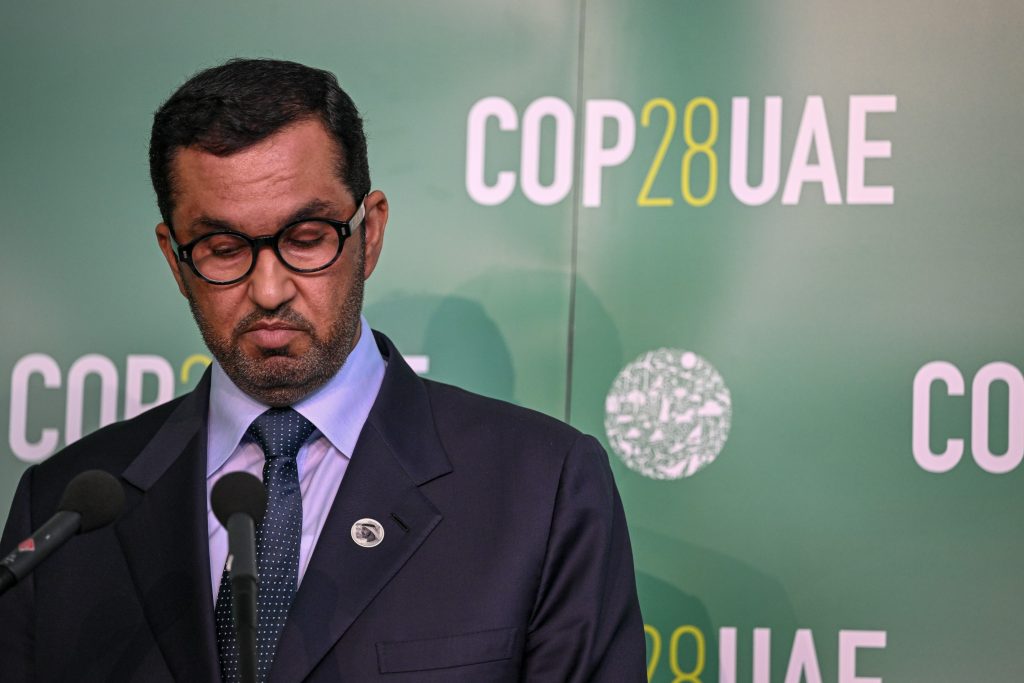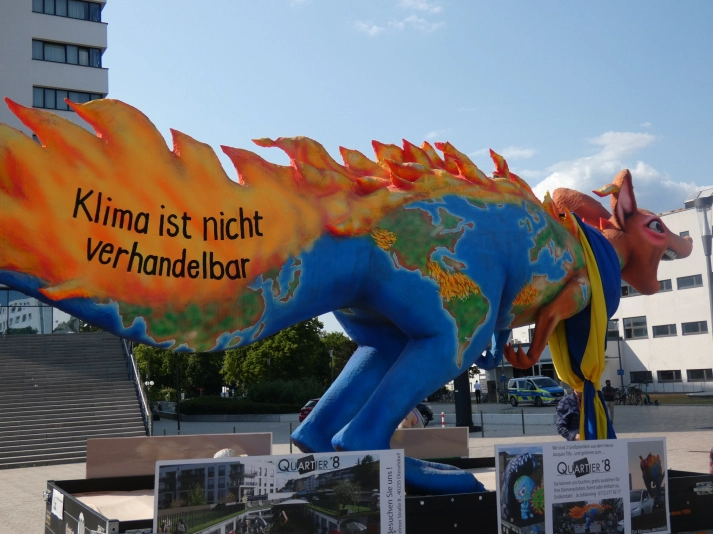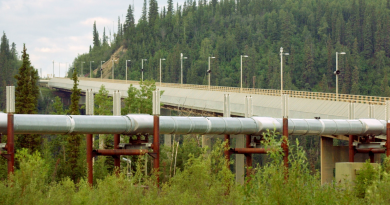Blog: COP28 Countdown—Bonn UN climate talks try to smooth rocky path to Dubai

The thermometer on the UNFCCC building here in Bonn is showing high summer temperatures early in the season, as the delegates line up for the climate talks from June 5th to 15th.
Bonn is the headquarters of the United Nations climate change body. This 10-day meeting is preparing the way for COP 28 in Dubai in November. And that key meeting is to tackle the “Global Stocktake”, which the UN climate body describes as a “critical turning point when it comes to efforts to address climate change”. Half way between COP27 in Egypt and this year’s meeting, the situation is not looking good.
CO2 levels have reached a record high.
🌎📈 424.46 ppm #CO2 in the atmosphere on Jun. 9 2023 📈 Up 3.13 from 421.33 ppm one year ago 📈🌎 @NOAA Mauna Loa data via “MKO”: https://t.co/nu6ktMn2wU 🌎 https://t.co/DpFGQoYEwb Daily: https://t.co/PTTkLiPGm2 🌎🙏 Pls. help make this global sustainability # visible 🙏 pic.twitter.com/K51GiwvKK1
— CO2_Earth (@CO2_earth) June 10, 2023
Temperatures have been spiking around the globe:
🌡 May was the joint-second warmest on record,
🌡 Record sea surface & marine air temperature,
❄️ The Antarctic sea ice extent marked a record monthly lowHere’s a glimpse of our latest Climate Bulletin 👉 https://t.co/W7Q3Y6l5x8 pic.twitter.com/u3Yrfh4daF
— Copernicus ECMWF (@CopernicusECMWF) June 9, 2023
Canada is experiencing devastating forest fires. This only really hit the headlines when the skies over New York turned orange and was hit by toxic smoke, causing havoc in the US mega-city. Disheartening for people in those fire-stricken regions.
At our @UN Headquarters in New York, we can feel the deteriorating air quality as smoke from the wildfires in Canada moves south.
With global temperatures on the rise, the need to urgently reduce wildfire risk is critical.
We must make peace with nature. We cannot give up. pic.twitter.com/pm8HkNBwRN
— António Guterres (@antonioguterres) June 7, 2023
At the same time, the Russian war against Ukraine continues. Aside from the tragic loss of life and global disruption, a study published to coincide with the talks shows that emissions generated over the first twelve months of the war totalled 120 million tons of CO2, according to the authors. This is almost the annual emissions of Belgium, whose per capita emissions in 2019 were the seventh highest in the European Union.
The war in Ukraine is deepening the climate crisis at time when global greenhouse gas emissions are already running at a record high.#Ukraine #UkraineWar #UkraineRussianWar #Climatechange https://t.co/lnMyC8i0cc
— The Telegraph (@ttindia) June 6, 2023
The latest scientific reports on the icy regions of our planet tells us it is too late to save Arctic summer ice:
In the Arctic “the first ice-free summer could be in the 2030s”.
Meanwhile, one sector of the Antarctic continental shelf, the Bellinghausen Sea, already had an ice-free summer earlier this year. https://t.co/PSSzAyzsWC— Rob Larter (@rdlarter) June 6, 2023
…. while the Antarctic is being hit much faster and more rapidly than feared, with potentially catastrophic implications for lower-lying regions and small island states.
#Antarctic #ice loss projections have already been overtaken by reality and even leading climate scientists are surprised by the speed at which we are heading towards #tippingpoints.#ClimateChange #SeaLevelrise #AmbitionOnIce #ClimateConference #Bonn https://t.co/6chKehFVM9
— PolarJournal (@JournalPolar) June 8, 2023
Taking stock of climate action
Like the climate, the talks are hotting up. And time is running short. The delegates have their work cut out for them. A week into the talks, Parties are still squabbling about final agendas.
Week 1 of #BonnClimateConference ended without agreement on the meeting’s agendas
Awaiting news from Heads of Delegation, negotiators went on as usual debating draft text and crafting bridging proposals on capacity building, adaptation, and other issueshttps://t.co/GSS4RVii6D pic.twitter.com/IAVVFohUeH
— Earth Negotiations Bulletin (@IISD_ENB) June 10, 2023
The global stocktake (GST) is “a moment to take a long, hard look at the state of our planet and chart a better course for the future,” the UNFCCC says. So what have we been doing up to now? This will be an inventory of what progress countries and other stakeholders are making towards meeting the goals of the Paris Agreement – and where they fall short. “It means looking at everything related to where the world stands on climate action and support, identifying the gaps, and working together to agree on solutions pathways (to 2030 and beyond), ” the UNFCCC goes on.
It probably does not surprise Ice Blog followers that we are not actually doing too well. An analysis presented on the sidelines of the talk by the Climate Action Tracker (CAT) backs that up.
Cimate Action not on Track
CAT is an independent scientific project that tracks government climate action and measures it against the globally agreed Paris Agreement aim of “holding warming well below 2°C, and pursuing efforts to limit warming to 1.5°C. The producers, Climate Analytics and NewClimate Institute, have been providing this analysis to policymakers since 2009.
The findings presented in Bonn were sobering. CAT concludes that companies and governments around the world are continuing to expand fossil fuels, jeopardizing the Paris goals. None of the world’s largest fossil fuel producers have committed to ending new investments in oil and gas production and are instead increasing them, CAT finds. Only minor producers are commiting. The experts also found that most governments have failed to eliminate fossil fuel subsidies, despite longstanding promises to do so. G7 members also continue to support international public finance for fossil gas, despite pledging to end new international public finance for fossil fuels in 2022.

(Irene Quaile)
Carbon capture and storage
The CAT is highly critical of efforts by major oil and gas producers to promote technologies like carbon capture and storage. In their view, this is just a means of prolonging oil and gas production, and distracts from the real need to halve greenhouse gas emissions by 2030 and reduce global production of fossil fuels. The host of this year’s COP, the UAE, as the world’s 7th largest oil and 15th largest fossil gas producer, has officially been promoting an “emissions-free” fossil fuel agenda, the report says, “touting the use of CCS in the energy sector rather than phasing out oil and gas.”
While the IPCC has told us we will need negative emissions technologies like CCS to take CO2 out of the atmostphere, it must not be an excuse to keep on burning fossil fuels. The technology is not available at scale and still extremely expensive.
China Pushes Ahead With Carbon Capture While IPCC Warns Against It – https://t.co/qzddGDcO4V
China has launched its first offshore carbon capture and storage project, located in the South China Sea, and its largest carbon capture and storage facility is now operational at a…
— Svein Tveitdal (@tveitdal) June 12, 2023
All in all, according to CAT calculations, the world is on a path to a “catastrophic” temperature rise of 2.7 degrees Celsius by 2100 under foreseeable emission trends. UN reports (including by the IPCC or the UN climate convention’s secretariat) also suggest that current policies lead the world well past the 2C mark and clearly fail to meet the Paris Agreement
Where do we go from here?
There are other studies and reports, like the UN environment programme, which suggest that achievement of the Paris Agreement is within reach, “with a slight additional push”, says, Professor Joeri Rogelj, director of research at the Grantham Institute – Climate Change and the Environment and professor in climate science and policy at the Centre for Environmental Policy at Imperial College London. These estimates project warming already below 2C and moving towards the 1.5C limit, he writes in a guest post for Carbon Brief, entitled “what credible climate pledges mean for future global warming“.
The key to the widely differing estimates is in the “credible”.
In a study, recently published in Science, Rogelj and his colleagues looked at the reasons for the widely different forecasts, spanning “an unhelpfully broad range from ‘disaster avoided’ to ‘disaster confirmed’. “
The more positive estimates take all pledges at face value, both near-term pledges until 2030 – nationally determined contributions (NDCs) – and longer-term pledges until mid-century and beyond.
The others only consider policies that are on the books and being implemented.
“Taking into account only the most credible climate pledges, we find that warming would reach 2.6C by the end of the century. However, extending this to include all climate pledges brings it down to 1.7C.”
When it comes to deciding whether a net-zero target is “credible”, the scientists looked at whether it is legally binding; whether it is accompanied by a clear implementation plan; and whether a country’s current policies are already putting its emissions on a downward path.
Net-zero policies are ambitious but without a legal mechanism in place, they may not be effective. Making climate pledges legally binding is essential for catalyzing real change & reaching climate goals. Researchers from all over the world, including @WRIClimate weigh in:
— WRI Climate (@WRIClimate) June 9, 2023
In order to move closer to the Paris goal, Rogelj and his colleagues conclude, countries will need ambitious targets and pledges aiming for emissions reductions well beyond what current policies would achieve.
These pledges would have to be further strengthened and followed with policies, implementation and – crucially – delivery of the emissions reductions needed to avert dangerous warming.
That may seem like a no-brainer – But getting those promises turned into action is a tough task for the world’s climate negotiators.
United Arab Emirates (UAE) – the oil-backing COP host
The crowd was powerful!
The demands were clear!Today’s Climate Strike in #Bonn lead by youth activists called for #ClimateJustice and an Equitable phaseout of #FossilFuels! #EndFossilFuels #SB58 pic.twitter.com/1XXx5GHWol
— Climate Action Network International (CAN) (@CANIntl) June 9, 2023
The fact that this year’s UN climate conference will be hosted by the UAE is highly controversial. The COP28 President Sultan al-Jaber, who is also UAE’s Minister of Industry and chief executive of the Abu Dhabi National Oil Company, has repeatedly resisted calls for an end to fossil fuels. At a diplomatic reception here in Bonn, his first (brief) appearance at a United Nations climate meeting this year, he did actually say for the first time: “The phasedown of fossil fuels is inevitable,” going further than countries agreed in Glasgow two years ago when the focus was coal, but still stopping short of advocating a complete ban, the news agency AP reports.
“As we have learned from past experience, the more progress we make in Bonn, the higher the likelihood of success in December,” COP President al-Jaber said.
Indeed.
At the same time he continued to insist that the goal should be a global energy system “free of unabated fossil fuels.” The term abated refers to measures taken to reduce or capture greenhouse gas emissions from the burning of fossil fuels, as I discussed above.
The crowd was powerful!
The demands were clear!Today’s Climate Strike in #Bonn lead by youth activists called for #ClimateJustice and an Equitable phaseout of #FossilFuels! #EndFossilFuels #SB58 pic.twitter.com/1XXx5GHWol
— Climate Action Network International (CAN) (@CANIntl) June 9, 2023
French MEP Manon Aubry recently described the UAE Presidency as “like having a tobacco multinational overseeing the internal work of the World Health Organization”, the Guardian reports. The former UN climate chief Christiana Figueres has called his approach “dangerous”. COP28 Director General Majid Al Suwaidi jumped to the defence of al-Jaber as President, saying having a CEO to head COP for the first time in the climate summits’ history, and moving away from having a purely political process, would help deliver results from the December meeting. However, Al Jaber’s team has also been accused of Wikipedia “greenwashing” and running „an army of fake social media accounts to defend the UAE Presidency of the climate summit.
Bad news for our ice and snow regions
The cryosphere is a top priority, given the increasing impacts of diminishing sea ice, melting glaciers, ice sheets, permafrost and snow on sea level rise, water-related hazards and water security, economies and ecosystems. #MeteoWorld 🔗 https://t.co/WvnTp2e4Gb pic.twitter.com/2JhYoJgg1T
— World Meteorological Organization (@WMO) May 29, 2023
The World Meteorological Organization announced that it will elevate the cryosphere to one of its top priorities, given the increasing impacts of diminishing sea ice, melting glaciers, ice sheets, permafrost and snow on sea level rise, water-related hazards and water security, economies and ecosystems. The WMO also published a report last month suggesting that for the first-time it is more likely than not that global surface temperature will exceed pre-industrial levels by 1.5 degrees in at least one of the next five years. While the possible overshoot of warming targets may be temporary, not all the associated impacts are necessarily reversible.
My first update of 2023 for changes in land ice mass observed by GRACE(-FO) satellite in Antarctica (left) and Greenland (right) 🧊📉
Methods can be found from @NASAClimate at https://t.co/8X9AWJFB9O. My visualization can also be downloaded: https://t.co/53ZaRhYYry pic.twitter.com/iflhGhU6be
— Zack Labe (@ZLabe) June 9, 2023
The latest research indicates that to preserve the cryosphere, the ice and snow regions of the globe, even a 1.5°C rise in temperature could be too high. An increasing number of studies published in the past year are converging on temperatures between 1.5°C and 1.8°C as critical thresholds triggering irreversible loss of portions of the ice sheet, especially the West Antarctic Ice Sheet (WAIS), but also portions of East Antarctica, long thought of as a “last bastion” immune to climate warming. The WAIS alone holds four meters of potential sea-level rise, enough to wipe out coastlines in many low-lying nations. For low-lying countries and small island states, preserving the frozen state of our icy areas is therefore a matter of survival.
My first update of 2023 for changes in land ice mass observed by GRACE(-FO) satellite in Antarctica (left) and Greenland (right) 🧊📉
Methods can be found from @NASAClimate at https://t.co/8X9AWJFB9O. My visualization can also be downloaded: https://t.co/53ZaRhYYry pic.twitter.com/iflhGhU6be
— Zack Labe (@ZLabe) June 9, 2023
20 countries have signed up to a high-level coalition Ambition on Melting Ice (AMI) to increase pressure to keep to the 1.5C that will limit the damage to the polar ice, mountain glaciers and the rest of the cryosphere. The group, formed at COP27, has been active here at the Bonn talks to increase awareness of the global impacts of ice loss. It is interesting that some of the big players – or a key potential sufferer like Bangladesh – are not (yet) part of the alliance. The group includes not just polar and mountain regions (Iceland and Chile co-chair, Nepal is a member), but Liberia or Vanuatu, countries highly vulnerable to sea-level rise.
“To maintain the possibility of staying below 1.5°C, CO2 emissions must be at least halved by 2030, and reduced to zero by mid-century. Committing to anything less will result in catastrophic Antarctic ice sheet loss that would erase all human settlement along many coastlines within the next few centuries, displacing hundreds of millions of people and erasing some nations from physical land existence,” said Pam Pearson, Director and Founder of the International Cryosphere Climate Initiative (ICCI), in Bonn for the talks.
“We’re already in the era of #LossandDamage. Without a decision of #fossilfuels and not just #fossilfuel emissions, we will have failed.” #COP28 must deliver a clear political signal on the future of #energy @RRegenvanu pic.twitter.com/tTjS00DJNU
— UNCS News (@UNClimateSummit) June 7, 2023
Securing the funds to help countries suffering “loss and damage” from climate change continues to be one of the main bones of contention in the negotiations. Billions are at stake for a loss and damage fund. But many rich countries are using “delaying tactics“, criticizes Harjeet Singh of CAN International.
“We’re already in the era of #LossandDamage. Without a decision of #fossilfuels and not just #fossilfuel emissions, we will have failed.” #COP28 must deliver a clear political signal on the future of #energy @RRegenvanu pic.twitter.com/tTjS00DJNU
— UNCS News (@UNClimateSummit) June 7, 2023
The negotiators in Bonn spend hours struggling with wording, with countries defending their own (economic) interests and holding up the proceedings when necessary. NGOS and other observers are working hard in the background, side events and cafeteria chats, to persuade the negotiators to take their points into the discussions. Here’s hoping the 4,000 or so negotiators and observers in Bonn can make enough progress to put the Dubai conference on the right track in the few days that remain.

I’ll give the last word to Namgay Choden, a young delegate negotiating for Bhutan, just one example of climate injustice. She told a side event in Bonn her country was currently a negative emitter, one of the least developed countries, having contributed least to emissions – yet one of the most vulnerable and least equipped to deal with human-made climate change, which had been a threat to her since she was a child. She experienced a flood, which came as a “reality check of the disruption climate change can cause.”
Bhutan is rapidly losing glaciers. This will not only impact water and food security, Namgay says. There is a flood risk to forests, biodiversity, people, the economy. The hydropower her people rely on is under threat.
“I’m here as a young person to advocate for my country’s very existence”, she said in a moving plea to fellow delegates and observers. But she also wants to give a message of hope.
“The world needs needs Bhutan as inspiration, as a source of optimism”, she says, “how a small country can be an environmental champion. But Bhutan also needs the world…to reduce emissions and halt climate change.”
Related stories from around the circumpolar world:
Antarctica: Antarctic changes could become tipping points with global implications, says report, Eye on the Arctic
Canada: Arctic could be ice-free as early as 2030s says study, Eye on the Arctic
Greenland: Climate change accelerating ice loss from peripheral glaciers, Eye on the Arctic
Finland: Unusually warm April weather, sunshine records in northern Finland, Eye on the Arctic
Sweden: High risk of wildfires in many parts of Sweden, including North, Radio Sweden
United States: Bering Sea ice at lowest extent in at least 5,500 years, study says, Alaska Public Media



